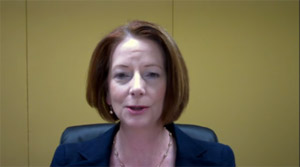Telework assists govts in crisis, but not for everyone

Prime Minister Julia Gillard and US Ambassador to Australia Jeffrey Bleich have talked up the benefits of teleworking to the government in times of disaster and crises at the launch of National Telework Week in Melbourne this morning.

Prime Minister Julia Gillard via TelePresence.
(Screenshot by Josh Taylor/ZDNet)
Gillard announced this morning, via TelePresence, that the government will set the target for getting 12 percent of the Australian Public Service regularly teleworking by 2020.
"We can be demonstrating, as a big employer, the options and choices for other employers," she said.
When asked how her government is using teleworking, Gillard said that Cabinet meetings are sometimes conducted through the Cisco TelePresence facilities that were rolled out in 2009, and that these facilities are vital when the government needs to be briefed during emergencies.
"When we face the need to get briefed urgently on situations that may be very, very serious ones, we also use teleworking, TelePresence, to reach around the world," she said.
"We met constantly as a national security committee during the days of the Japanese earthquake and tsunami, when we were wanting to get real-time reports on what was happening with the recovery, what was happening with our search and rescue team that had been deployed, and — importantly — what was happening with the Fukushima reactors."
Gillard said that through TelePresence, the government was able to meet with nuclear experts and the Japanese ambassador during the crisis.
Bleich said that around 16 million Americans telework at least one day per month, saving approximately 1.5 billion litres of petrol per year. During the recent Hurricane Sandy, which swept through many eastern states in the US, Bleich said that teleworking was critical.
"Teleworking was vital to our government and to our emergency services in order for them to maintain continuity of operations," he said. "Even though we had closed many government offices, including all of Washington DC, one third of the 300,000 federal employees who normally work in Washington at that time were able to continue working under their continuity of operation plan.
He said that normally, only 8 percent of federal employees in Washington telework, but that it rose to 33 percent during the storm.
While the Australian government has set a goal of 12 percent for the public service to be teleworking, she admitted that it wouldn't work for every job.
"I don't think it is going to be there for the whole economy. There are a number of jobs where the nature of doing the task is that you must be physically present in a particular space in a particular time," she said.
"It is not going to replace all ways of working, but I think for many workers, it will give them an option for a section of their work, and for some workers it can give them an option for all of their work."